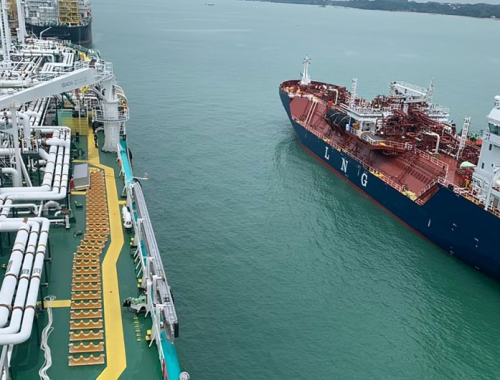EU should focus on blue hydrogen imports closer to home: CATF
SUMMARY
The Clean Air Task Force has proposed that the EU’s hydrogen strategy should focus on producing and importing low-carbon hydrogen from natural gas, or blue hydrogen, in the nearer term to accelerate reductions in CO2 emissions by 2030.
By Gary LakesPOSTED IN:
The Clean Air Task Force (CATF) has put forward a proposal for the EU, calling for increased focus on the development of blue hydrogen, derived from natural gas. It calls for the block to produce this hydrogen at the point of use, or import it from nearby sources by pipeline. This would reduce transportation costs and establish a hydrogen economy faster, ready for when green hydrogen is sufficiently available and at a lower cost.
According to CATF, blue hydrogen has the potential to transform Europe's energy landscape. Its new report – Techno-economic Realities of Long-Distance Hydrogen Transport – looks at the least costly options for transporting low-carbon hydrogen in large quantities over long distances while addressing technology challenges in the process. It also outlines several policy recommendations for developing a cost-effective, low-carbon hydrogen economy for Europe during the transition period.
Its policy recommendations for Europe include: promoting carbon capture and storage (CCS) technology; establishing regulatory frameworks; facilitating cross-border collaboration; decarbonising energy-intensive industries; and developing hydrogen infrastructure.
Global efforts to decarbonise are expected to increase demand for low-carbon hydrogen. This will in turn create the need to develop transport systems between low-cost producers and centres where hydrogen demand will be high, according to the report.
But hydrogen’s fundamental properties make transporting it over long distances costly and technologically challenging. To examine this issue, CATF commissioned Houston-based KBR Inc. to model the cost of delivering low-carbon hydrogen from likely producing regions to the Port of Rotterdam.
According to the findings, CATF said the molecule’s properties, particularly its low volumetric energy density, makes transporting hydrogen over long distances expensive and relatively inefficient no matter whether by ship or by pipeline. But transporting it by pipeline consistently ranks as the most cost-efficient option in the short and long term, CATF said. The report found that owing to economies of scale, the cost of delivering hydrogen declines with higher import volumes for all carriers and export locations, and either way, pipeline transport consistently ranks as the most cost-efficient option. Furthermore, the transport of uncracked ammonia as a hydrogen carrier is cheaper than simply hydrogen molecules, even if the latter is delivered via pipeline.
Estimates of overall cost per kilogram of hydrogen delivered to Rotterdam were developed for 250,000, 1mn and 10mn tonnes/year – amounts assumed to be reached in 2030, 2040, and 2050, respectively. By accounting for each element of the value chain in developing these cost estimates, the analysis aimed to elucidate the implications of different choices with respect to hydrogen carrier, mode of transport, and export location, the report said.
The modelling used by KBR followed four different transportation pathways: (1) Pipeline transport of gaseous hydrogen from Algeria and Norway. Maritime transport of either (2) liquid hydrogen, (3) cracked and uncracked ammonia, or (4) liquid organic hydrogen carriers (LOHC) from Norway and the Arabian Gulf, as well as North and South America.
The focus was on hydrogen produced with natural gas and carbon capture. This option was selected because low-carbon hydrogen can scale more rapidly than electrolytic (renewable) hydrogen, which requires abundant zero-carbon electricity. This approach made the modelling in the report more relevant to decision makers in the near term. However, the calculated costs to export, transport, and import hydrogen should also apply to hydrogen produced via any other means.
Taken together, the findings from this study underscore the numerous hurdles to transporting hydrogen by sea, which include, but are not limited to, the inherent energy requirements (and potential emissions implications) of associated processes, the report said. Recognising these challenges, CATF concurs with the overall conclusion reached by a recent European Commission study, which found that most of the hydrogen needed to meet future European demand will likely be either (1) produced near the point of end-use or (2) imported by pipeline.
Transporting LNG to Europe and using it to produce hydrogen at the point of import (with low-carbon energy inputs and carbon capture) will likely be more feasible and cost-effective than importing low-carbon hydrogen from distant suppliers, the CATF said. This option was not considered in the KBR analysis but bears further exploration, especially since EU countries are currently building out an extensive LNG importing infrastructure following the disruption to European gas markets in early 2022.
Conclusions
The report also suggests that Europe re-evaluate its plans for hydrogen imports. The report points out that a number of EU members have already recognised the need for more low-carbon hydrogen and made plans to rapidly scale up production and imports. The group plans to produce 10mn t/yr domestically and import an equal amount by 2030.
According to CATF’s production and export director Ghassan Wakim, global decarbonisation is going to require a multifaceted response that explores a variety of technologies and decarbonisation strategies. “We must take care in developing public policies and deploying public resources to prioritise the most promising and cost-effective technologies first,” Wakim said in a release from CATF, adding that “it is important to avoid expensive investments in infrastructure that is inherently inefficient.”
In that regard, the CATF said hydrogen deployment should prioritise “no regrets” sectors that include existing uses of hydrogen as a chemical feedstock, for example, refining, ammonia, and methanol, and future uses in hard-to-abate sectors. “These are sectors where there are no other energy-efficient or cost-effective options,” the group said.
It urged Europeans to think realistically about viable domestic production and import pathways for hydrogen and follow a “technology open approach” for scaling hydrogen based on the merits of emissions reduction, technical feasibility, and cost effectiveness.
Broadly speaking the CATF said: “Resources should be leveraged to prioritise the most promising and cost-effective technologies first, recognising that, while having options is important, so is avoiding expensive investments in infrastructure that are inherently inefficient or unlikely to be used. The reality is that additional technologies and a deeper paradigm change will be needed to achieve emissions neutrality in Europe.”






